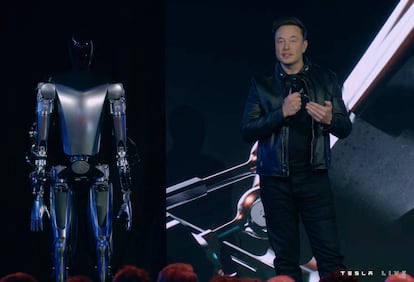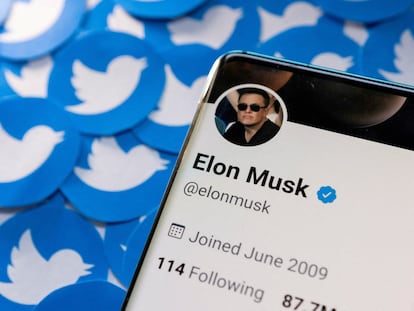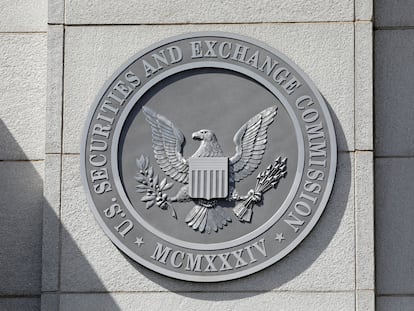Meet Optimus, Tesla’s humanoid robot
Elon Musk’s lackluster unveiling of his new project, which is expected to cost $20,000, fails to impress many

Its name is Optimus – it’s five feet eight inches tall (1.73 meters) and weighs 125 pounds (57 kilos). Optimus can walk, carry packages, water plants and move objects, although not very well. Elon Musk opened Tesla’s AI Day 2022 by unveiling a prototype of its humanoid robot, which the company hopes to mass produce and sell for under $20,000. The robot’s shape and function are inspired by human beings, but also draw on Tesla’s car manufacturing expertise. “It’s a shift from robots on wheels to robots on legs,” said an Optimus technician.
At last year’s AI Day, Musk brought out a person in a robot suit. This year, he brought out an actual humanoid. The robot took a few awkward steps, waved mechanically, and walked off stage at Tesla’s offices in Palo Alto, California. “The robot can actually do a lot more than what we just showed you, but we didn’t want it to fall on its face. We’ll show you some videos now of the robot doing a bunch of other things,” said Musk.
The company then presented videos of a cable-tethered Optimus awkwardly performing some simple tasks. The technicians spent a long time explaining how difficult it is to get a robot to walk without falling and to manipulate objects. “There’s still a lot of work to be done to refine Optimus,” admitted Musk.
Tesla then brought out an even more rudimentary prototype of the next generation Optimus robot. While the first generation Optimus prototype was somewhat clunky looking, the second one had a cleaner, sleeker design. But it could barely stand upright and nearly fell over before technicians caught it. “As usual, Tesla’s demos are coming in hot,” joked Musk, perhaps remembering when a Tesla vehicle’s “indestructible” glass shattered in mid-presentation three years ago. “It wasn’t ready to walk today, but I think it will in a few weeks.”
JUST IN: Tesla, $TSLA officially unveils AI bot 'Optimus'
— Watcher.Guru (@WatcherGuru) October 1, 2022
pic.twitter.com/OTyryDdkwQ
“Our goal is to make a useful humanoid robot as quickly as possible. We’ve designed it with the same discipline as our cars – that is, so that we can mass produce low-cost, high-reliability robots. That’s incredibly important,” said Musk in his opening remarks. Musk wants robots that can perform tasks to achieve “a future of abundance” and a “transformation of civilization.”
Tesla’s robot is plainly clumsier than other prototypes. Japanese companies like Toyota and Honda have developed more agile robots that can even shoot and sink baskets. But Musk defiantly said: “You’ve seen demonstrations of very impressive humanoid robots. And that’s great, but what are they missing? A brain. They don’t have the intelligence to navigate the world on their own. They’re also very expensive and can only be manufactured in small numbers. Optimus is designed to be an extremely capable robot that can be mass produced, potentially millions of units, and is expected to cost much less than a car. I would say probably under $20,000 – that would be my guess.”
The robot’s power source is a battery embedded in its chest, and is designed to be energy efficient. It has a main board for artificial intelligence and a navigation system similar to the one in Tesla’s autonomous cars. This navigation system was a main focus throughout Tesla’s AI Day.

Optimus has built-in cameras and sensors, wireless connectivity, audio capabilities and strength transmission points so it can move around, and hold and carry objects. “It has important hardware safety features for protecting the robot and the people around it,” explained the mechanical engineer in charge of the project.
Musk is well aware that there is still a lot of room for improvement. One of his goals is to manufacture enough robots to test them as workers in Tesla’s factories. In the meantime, Tesla will focus on improving their capabilities. But that’s not all, promised Musk during the audience Q&A session. “We want to have really fun versions of Optimus that can be useful and perform tasks, but can also be a kind of friend and companion to hang out with you. And I’m sure people are going to find all sorts of creative uses for this robot.”
“Eventually, we may have an android like the ones in science fiction movies like Star Trek: The Next Generation. We could program the robot to be friendlier and less robotic, to learn to emulate humans and feel very natural. As artificial intelligence improves overall, we can add those advances to the robot. Obviously, it should be able to obey simple instructions, and maybe even intuit what you want,” said Musk.
Musk promised, “We always want to be careful we don’t go down the Terminator path,” alluding to the sci-fi film saga in which robots rebel against humans. There will be safeguards, including the ability to shut it down and update its operating system over the internet. Musk says that from a governance standpoint, Tesla is a good entity to undertake the robot project. “We are a publicly traded company. And that means the public controls Tesla, which is fine. So if I go crazy, you can fire me. This is important.”
Tu suscripción se está usando en otro dispositivo
¿Quieres añadir otro usuario a tu suscripción?
Si continúas leyendo en este dispositivo, no se podrá leer en el otro.
FlechaTu suscripción se está usando en otro dispositivo y solo puedes acceder a EL PAÍS desde un dispositivo a la vez.
Si quieres compartir tu cuenta, cambia tu suscripción a la modalidad Premium, así podrás añadir otro usuario. Cada uno accederá con su propia cuenta de email, lo que os permitirá personalizar vuestra experiencia en EL PAÍS.
¿Tienes una suscripción de empresa? Accede aquí para contratar más cuentas.
En el caso de no saber quién está usando tu cuenta, te recomendamos cambiar tu contraseña aquí.
Si decides continuar compartiendo tu cuenta, este mensaje se mostrará en tu dispositivo y en el de la otra persona que está usando tu cuenta de forma indefinida, afectando a tu experiencia de lectura. Puedes consultar aquí los términos y condiciones de la suscripción digital.
More information
Últimas noticias
Most viewed
- Alain Aspect, Nobel laureate in physics: ‘Einstein was so smart that he would have had to recognize quantum entanglement’
- Mexico’s missing people crisis casts a shadow over World Cup venue
- Why oil has been at the center of Venezuela-US conflicts for decades
- Trump clarifies who is ultimately in charge in Venezuela: ‘Me’
- Mexico seeks to shore up its defenses following US incursion in Venezuela











































